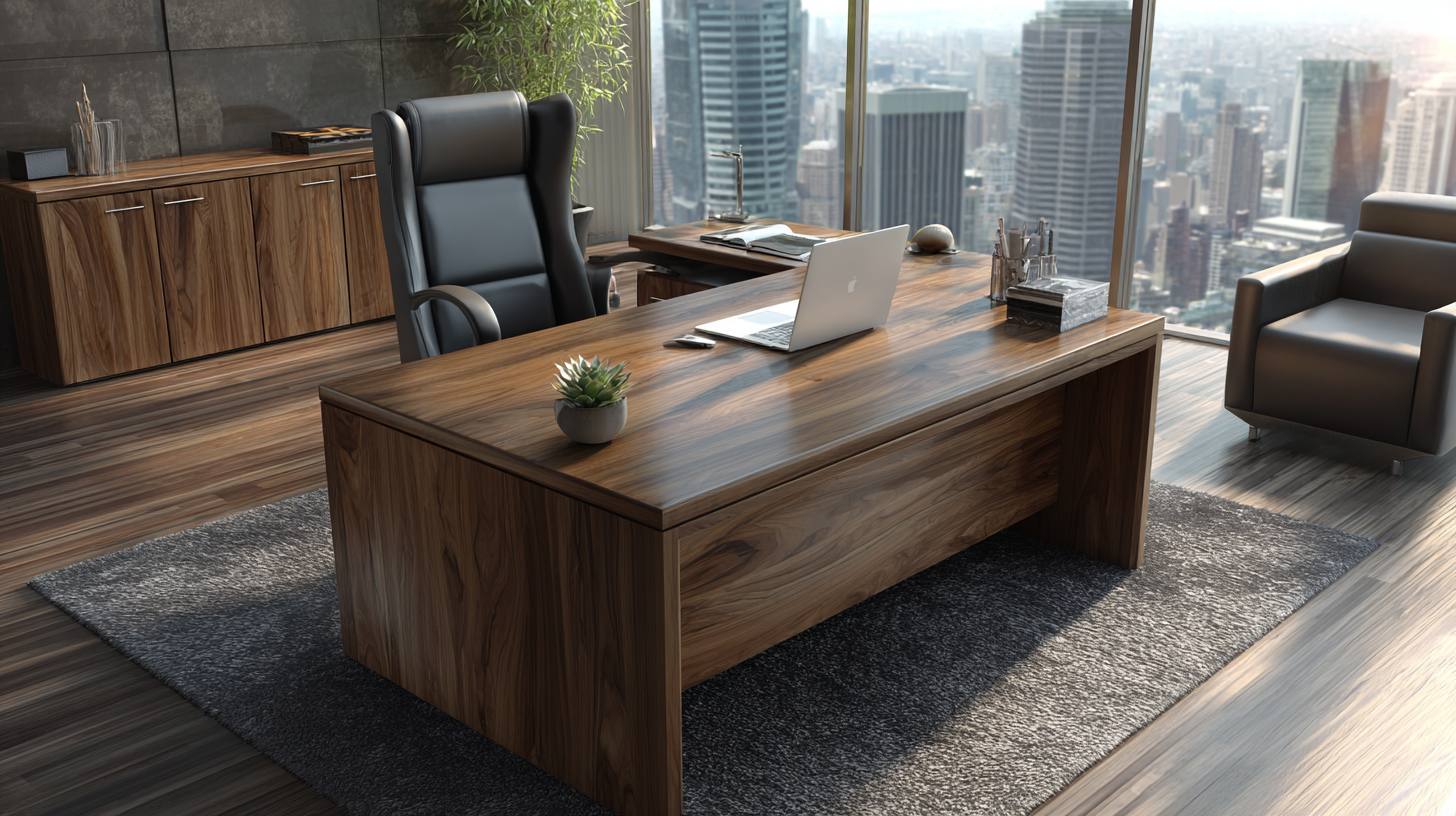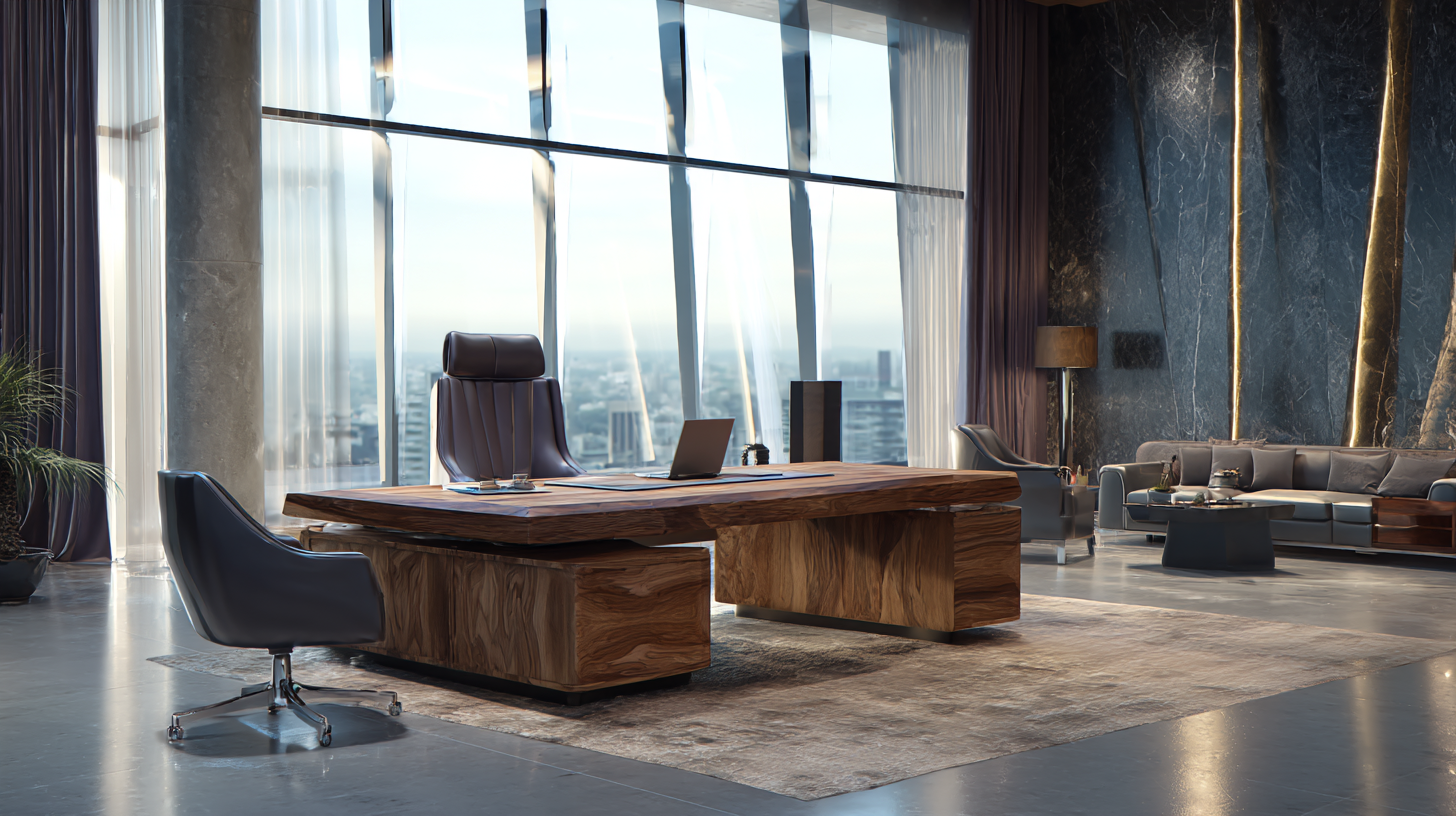The Ultimate Guide to Choosing the Best Executive Desk for Your Office
In the competitive landscape of modern offices, the choice of furniture plays a pivotal role in shaping productivity and professionalism. Among the essential pieces, the executive desk stands out not only for its functionality but also as a statement of status and style. According to a recent report by IBISWorld, the office furniture manufacturing industry is projected to reach $12 billion in revenue by 2024, reflecting a growing demand for high-quality office pieces that combine aesthetics and ergonomics. With an increasing emphasis on creating efficient work environments, choosing the right executive desk is crucial for both individual performance and the overall ambiance of the workplace. This guide aims to navigate through the vast array of options available, focusing on key factors such as design, material, and functionality to help you make an informed decision that aligns with your office needs.

Key Factors to Consider When Selecting an Executive Desk for Your Office Space
When selecting an executive desk for your office space, several key factors can significantly influence both functionality and aesthetics.
First, consider the desk's size and shape. It should fit comfortably within your office dimensions while allowing easy movement and access to related office equipment. An L-shaped desk may be ideal for corner spaces, maximizing the use of available area, while a traditional rectangular desk works well for more spacious environments.
Next, prioritize the materials used in the desk's construction. High-quality woods like mahogany or cherry offer durability and a classic look, while modern materials like glass or metal can provide a sleek, contemporary feel. Make sure the desk complements your office's overall design theme.
Tips: Always measure your office before purchasing to ensure the desk will fit well without overcrowding the space. Additionally, think about your workflow: a desk with built-in electrical outlets or cable management systems can greatly enhance your efficiency. Finally, don't forget about the ergonomic aspect; selecting a desk at the right height can contribute to better posture and comfort during long working hours.
Understanding Ergonomic Standards for Executive Desks in Professional Environments
When selecting an executive desk for your office, it’s crucial to prioritize ergonomic standards to promote comfort and productivity. According to the American National Standards Institute (ANSI), an ideal desk height for most users ranges from 28 to 30 inches, allowing for proper limb position and reducing strain on the back and neck. Furthermore, a report by the Global Workplace Analytics reveals that a well-designed ergonomic workspace can increase employee productivity by up to 15%. This underscores the significance of investing in a suitable executive desk that aligns with these standards.
Additionally, the desk design should incorporate adjustable features. A study published in the Journal of Occupational Health Psychology found that employees who have the ability to adjust their desk height report a 25% increase in job satisfaction and a significant reduction in discomfort levels. Selecting an executive desk with these ergonomic considerations not only enhances the overall functionality of your workspace but also fosters a healthier work environment, leading to higher employee retention and morale.
The Ergonomic Standards for Executive Desks
Material Choices: How Wood, Metal, and Laminate Affect Durability and Aesthetics
When selecting the perfect executive desk, the choice of material plays a crucial role in determining both durability and aesthetics. Wood, metal, and laminate each offer unique benefits, appealing to different tastes and functional needs. According to a recent industry report by IBISWorld, the wooden desk market has shown consistent growth, with solid wood desks ranked among the most durable options, often lasting over 20 years with proper care. The natural grain of wood not only adds warmth and elegance to an office but also works well with various interior design themes, making it a timeless choice for executives.
Metal desks, on the other hand, are gaining popularity due to their modern aesthetics and exceptional durability. A study by Statista reveals that the metal office furniture segment is projected to grow by 5.2% annually over the next five years. Metal desks are resistant to scratches and dents, making them ideal for high-traffic environments. They can easily complement contemporary office styles, offering a sleek, industrial look that many professionals prefer today.
Laminate desks present an economical alternative, providing versatility and style without sacrificing durability. Research conducted by the Furniture Foundation indicates that laminate surfaces can withstand considerable wear and tear, often lasting 10-15 years, depending on use. These surfaces come in a wide range of colors and patterns, allowing businesses to customize their workspace while keeping costs in check. Overall, the choice of material influences not just the desk's longevity but also its ability to enhance the overall ambiance of an executive office.

Impact of Desk Size and Shape on Office Layout and Workflow Efficiency
When choosing the best executive desk for your office, the size and shape of the desk significantly influence the overall office layout and workflow efficiency. A well-structured space promotes not only aesthetics but also enhances productivity. For instance, a narrow desk can be ideal for tight office layouts, maximizing the usable area without compromising on functionality. By carefully selecting desk dimensions, employees can avoid feeling cramped, thereby fostering a healthier work environment that encourages collaboration and creativity.
The design of the office itself contributes notably to employee well-being. Research indicates that thoughtful workplace design can improve health and satisfaction, directly affecting performance. An executive desk positioned strategically within an office layout can streamline processes, reduce distractions, and enhance personal interactions among team members. As innovative furniture designs continue to emerge, embracing these options can lead to a workspace that not only looks great but also supports the versatile needs of modern employees, aligning with evolving work styles and collaboration efforts.
The Ultimate Guide to Choosing the Best Executive Desk for Your Office
| Desk Shape | Desk Size (L x W x H in cm) | Recommended Office Size (sq ft) | Workflow Efficiency (Rating 1-5) | Storage Options |
|---|---|---|---|---|
| Rectangular | 180 x 90 x 75 | 120 - 180 | 4 | Drawers, Shelves |
| L-Shaped | 150 x 150 x 75 | 200 - 250 | 5 | Cabinets, Drawers |
| U-Shaped | 200 x 200 x 75 | 250 - 300 | 5 | Multiple Shelves, Drawers |
| Round | 120 dia x 75 | 80 - 120 | 3 | Limited Storage |
| Standing | 160 x 80 x 110 | 100 - 150 | 4 | Shelf, under-desk storage |
Budgeting for Quality: Evaluating Cost vs. Features in Executive Desk Selection
When it comes to selecting the perfect executive desk for your office, budgeting is a pivotal aspect that shouldn’t be overlooked. While it's tempting to aim for the least expensive option, the value often lies in the blend of quality and features, which can significantly affect your workspace’s functionality and aesthetics.
 Consider what features are essential for your daily tasks. A desk with integrated storage might save space and keep you organized, while a model that accommodates advanced technology can enhance your efficiency.
Consider what features are essential for your daily tasks. A desk with integrated storage might save space and keep you organized, while a model that accommodates advanced technology can enhance your efficiency.
Tips: To evaluate costs versus features effectively, create a checklist of must-have attributes. This might include size, material, design, and additional functionalities such as built-in power outlets or cable management systems. Prioritize these features based on your work style and environment.
Additionally, it's wise to set a realistic budget before you start shopping. This budget should encompass not only the cost of the desk itself but also any additional expenses related to delivery and assembly. Investing in a quality desk might require a higher initial expense, but it typically offers greater durability and longevity, making it a cost-effective choice in the long run.
